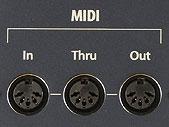

"I Want A MIDI" - Clarifying MIDI Misconceptions
2015-05-11 - Hauptwerk TechnicalA Common Cause
Is MIDI super-confusing to you? You are not alone. Don't feel bad. Are you hesitating to move forward with a Hauptwerk instrument because you are worried about the MIDI aspects of it? You don't have to.
For one thing, Hauptwerk has a great intro video to show how a Hauptwerk instrument generally goes together. Another reason is, Hauptwerk community is one of the most helpful online communities I have ever seen. The Hauptwerk forum is full of kind and helpful people who can answer all sorts of questions. There are also people at MIDIWorks.ca and other companies who are willing to help you. However, let's look at some of the common misconceptions and confusing aspects of MIDI to help you understand what's going on.
MIDI Is Not Audio
Absolutely, the most important thing you need to understand is that MIDI is not Audio. There is no aspect of sound waves, or the making of sound, that relates to MIDI. All MIDI does is control the devices that make sounds. Once that concept is firmly grasped, you have a good chance of understanding the rest.
Technically speaking, MIDI is a language, or protocol, that manufacturers' software and devices use to communicate music-related instructions to each other.
It has a completely separate signal path from the audio stream (the signal stream that actually reproduces or synthesizes the sound).
What confuses many people is that many audio cards have MIDI input/outputs as well as audio input/outputs. Even more confusing is that the audio card only has one connection to the computer; usually a firewire, USB, thunderbolt, optical or other cable. However, path that the audio and MIDI information travels are separated internally.
A device chain like this:
Keyboard > USB MIDI interface > Computer/Software > Firewire audio interface > Amplifier > Speakers
Is pretty intuitive. It seems to go in a linear direction. You have the controlling device that goes to the thing that creates the sound which goes to the thing that makes the sound loud. Each is going through a separate device with a defined purpose kind of in a "straight line" from start to finish..
When you see a chain like this:
Keyboard > Firewire audio/MIDI interface > Computer/Software > Firewire audio/MIDI interface > Amplifier > Speakers
It can seem confusing. However, what's really happening is this and it's like the first example except it's all in the same physical box:
Keyboard > MIDI port of the Firewire audio interface > Computer/Software > Audio portion of the Firewire audio interface > Amplifier > Speakers
So, if you can keep in mind that the MIDI stream and the audio stream are separate, it will help you enormously to understand your Hauptwerk instrument. You'll know how the information flows from start to finish.
In Through the Out Door
If you're new to MIDI, you have probably looked at the MIDI jacks and been confused by the IN and OUT labels on the different devices. "Should I connect in OUT jack to the other OUT jack? They both say 'OUT'. Seems logical". Unfortunately, it's not correct.
The "IN" and "OUT" labels on a MIDI device are showing that that jack represents the pathway of the MIDI traffic for the device. Think of the outside of the device like it's the border to a country. The "IN" jack shows where the MIDI signals need to go if they are supposed to flow into the device. The "OUT" jack shows where the signals leaving the device will be coming from.
So, if we continue the country metaphor, if you want to drive from one country to the other directly, you take the OUT road of one country and go to the IN road of the country you want to go to. So, you take the MIDI OUT of one device and connect that, via a MIDI cable, to the MIDI IN of the next device in your signal chain.
Merge Right
Often times, MIDI devices have a "merge" function built into them. What that means is, when a MIDI signal comes into the IN port of a MIDI device, what comes out the OUT port is a combination of what the device generates and the signal that came into it. So, in the case of our own keyboards, if you plug the OUT of your top keyboard into the IN of your bottom keyboard, what comes OUT of the bottom keyboard is the combination of both the top and bottom keyboards.
I'm Thru With You
A MIDI THRU port takes whatever MIDI signals that come in the IN port and sends a copy of those signals out the THRU port.
This is useful if you need a MIDI signal to go into the device and have that identical signal, and not a combined signal, go to a second device as well.
Resources
These questions represent some of the things that I have seen that confuse people the most when it comes to MIDI connections. It's not an exhaustive list by any means. Understanding these basic concepts about MIDI will help demystify the rest rather quickly.
As mentioned before, the Hauptwerk forum is full of helpful people if you get in a pinch. We're usually around at MIDIWorks.ca as well to answer questions. You can also use the Meet & Greet page right here at Contrebombarde to find someone in your area with a Hauptwerk instrument if you want to see one in person or ask questions. Who knows? In the process, you might make a new friend.
A PHP Error was encountered
Severity: Notice
Message: Undefined property: stdClass::$art_pl_link
Filename: articles/view_cat.php
Line Number: 110
Comments